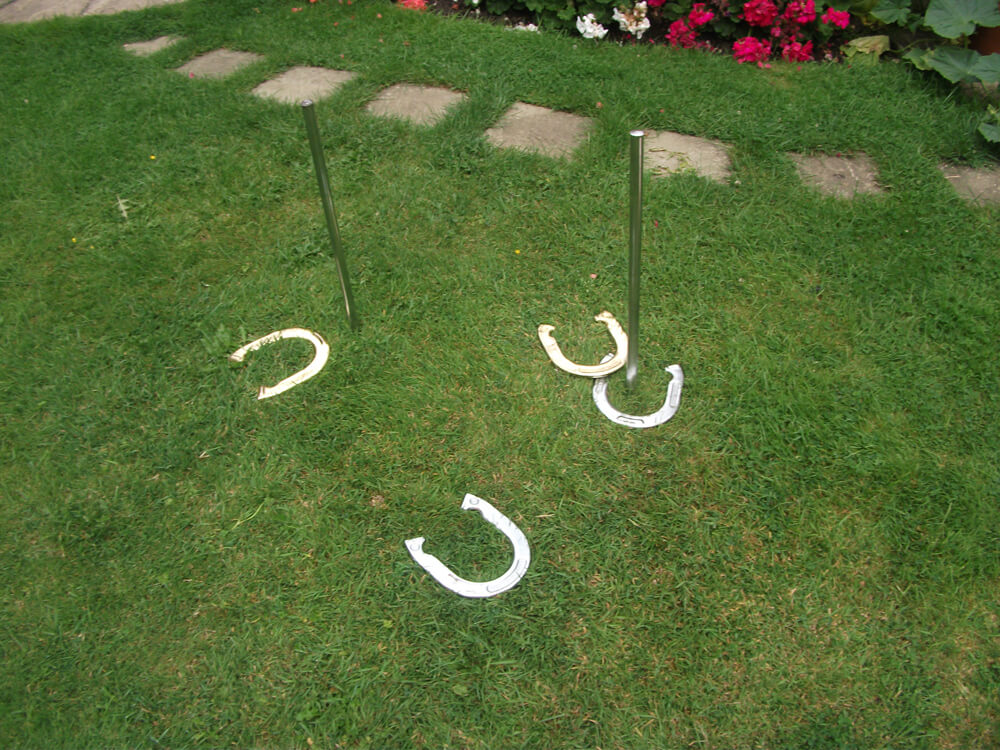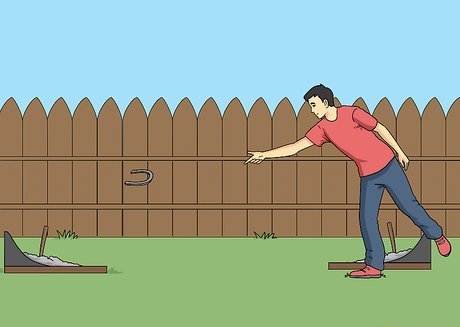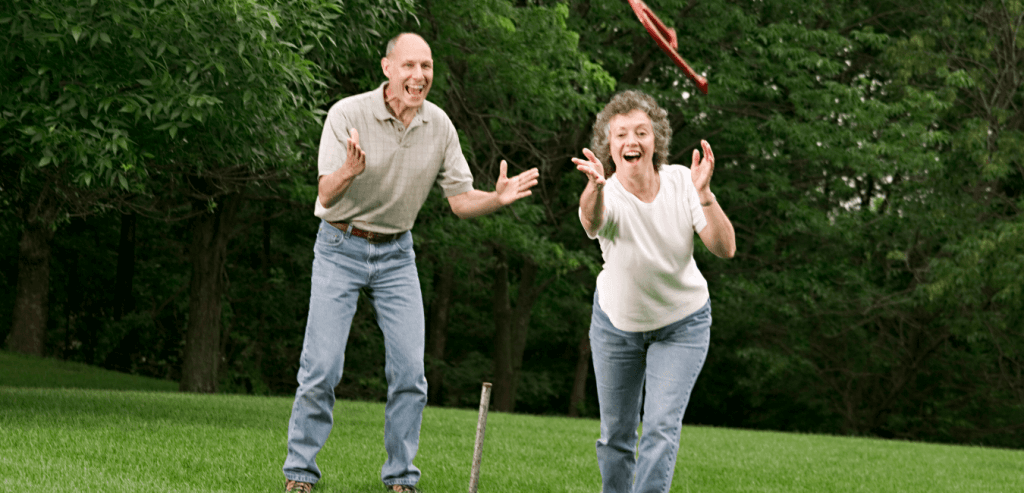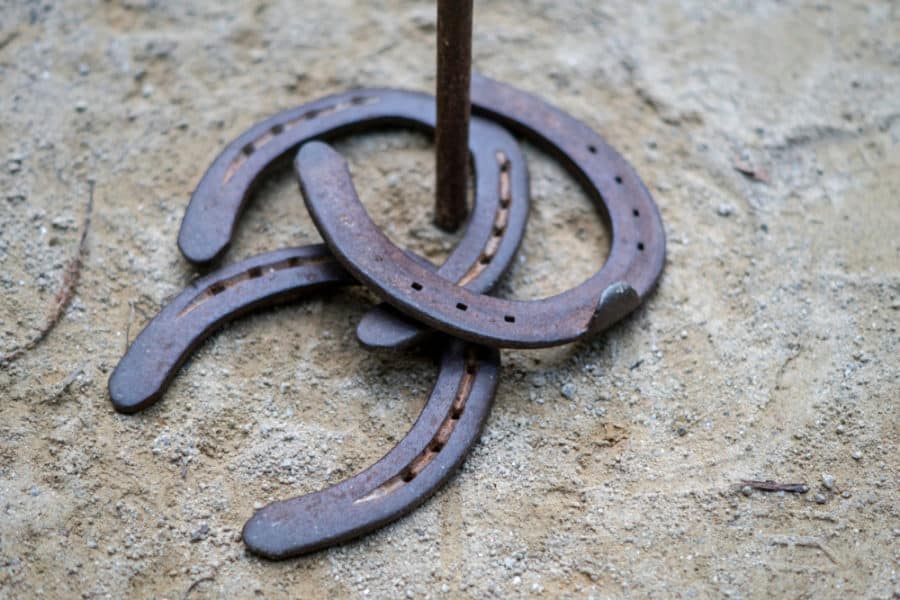This article offers an in-depth guide on how to throw horseshoes, a classic and engaging outdoor game.
It begins by outlining the basic setup of a horseshoe pitch, including the dimensions and components of the playing area, such as the pitching boxes, pits, and stakes.
The game aims to skillfully toss horseshoes toward a stake, aiming for precision and accuracy.
We delve into the essential components of a horseshoe, including the base, shank, heel caulk, hook, thumb cleat, and edge, which play crucial roles in the game’s strategy and scoring.
The scoring system, including point categories like ringers and learners, is explained in detail.
Furthermore, the article covers the fundamental rules of horseshoe pitching, emphasizing the importance of adhering to standardized dimensions and throwing techniques for competitive play.
Horseshoes: Game and its Basic Outline

There are two ‘pitching boxes’ of around six square feet in a typical horseshoe pitch at the two ends of the platform.
The pitching boxes consist of ‘pits,’ which measure around three by six feet and are centrally oriented, such that their longer side aligns with the longer edge of the pitch.
The pits are usually filled with sand, clay, or sawdust to absorb the landing shoe’s thrust and shall match the platform’s level.
A metal or hollow-steel stake of one-inch diameter is placed at either end of the courts in an inclined position, fifteen inches above the ground, in the middle of these pits.
A gap of forty feet is to be left in between the stakes.
There are two strips on either side of the pitching boxes wherein the players must stand and pitch.
The players switch alternately, tossing horseshoes and aiming at the stakes.
How to Throw Horseshoes: Components and Their Modification

- Base: The U-shaped middle section of the horseshoe.
- Shank: The extended straight ‘arms’ from the base. They are wide and flat in most traditional horseshoes.
- Heel caulk: The blunt projection on a horseshoe shank.
- Hook: The caulk’s inner edge is developed in a way that helps the horseshoe remain encircled around the stake in case of scoring a ringer.
- Thumb cleat: The raised ridge on the base is specially designed for a flip throw.
- Edge: The sports horseshoe differs from the traditional one due to the comfortable gripping edges for a smooth and controlled throw.
Close only counts in Horseshoes: The Scoreboard
The game requires 21 points to win. There are different sets and ways through which one can score points
- Six-pointers: If a player scores two ringers and the other manages to score none, six points are awarded.
- Four-pointers: A ringer plus the closest shoe together can fetch four points.
- Three-pointers: A ringer is awarded 3 points. A horseshoe with a straight edge that surrounds the stake and not touching it is called a ‘ringer.’ If a player scores one ringer but the other pitches two, even then, three points are scored.
- Two-pointers: It is scored when both the shoes are closer to the stake than the opponent.
- One-pointer: If not a ringer, the shoe is closer to the stake and scores one point. It includes ‘leaners’- a shoe within six inches from the stake.
Count-All rules: Players get credit for all the points scored, the maximum being six points for two ringers and the minimum being zero points when the shoes are beyond six inches from the stake or outside the pit.
Cancellation rules: The Horseshoe game is viewed as more fun because of the twists in its rules, as it lines up the possibility to cancel out opponents’ points.
Most cancellation games are played for 40 points. If both players score a ringer each, the points are canceled. The same is applied to all other equal plays in one turn.
Rules of Horseshoes

The best way to master any game relies on knowing the rules of it.
- If one is aiming for league competitions, each horseshoe’s weight should be around two pounds and ten ounces, length around seven and five-eighths inches, width seven inches, and the gap no wider than three and a half inches.
- Each player pitches two shoes in succession to one pit, called an inning.
- The opponent must patiently stand at the rear of the other platform while a player is pitching.
- Foul lines are drawn at 27 feet and 37 feet from the opposite stakes across the platforms. For adult males, pitching must be done behind the 37-foot line. For women, players under 18, and the elderly, pitching must be done from behind the 27 feet line. A player must not cross the foul line.
To gracefully throw a horseshoe and its perfect landing around the stake needs the right style and practice, which involves three steps:
1. Grip
Knowing how to throw horseshoes requires a perfect grip so that it encircles around the stake before coming to rest.
The best way to achieve the goal is to learn about the rules governing the game, the types of pitches that are usually followed, and tips to master the process perfectly.
- Flip Grip: It is the most common grip for shorter courts. The horseshoe is held with thumb flat on top, index finger at the ringer breaker’s right, two fingers around the inner edge, little finger at the bottom for support. The aim is to throw a horseshoe so that it flips with the lugs down.
- One-And-One-Quarter Turn Grip: The grip requires you to hold the shank and throw a horseshoe such that it rotates one and one-fourth times in the air before smoothly landing around the stake in a ringer. The horseshoe is needed to point in a direction opposite to your handedness. The thumb is then placed at the top with the three fingers curling up underneath, and a little finger is used to provide support. Wrist motion is restricted; thus, the shoe lands too flat around the stake after a nice wobble flight.
- Three-Fourth and One and Three-Fourth Turn Grip: The shank must point right (left for the left-handers) and throw a horseshoe counter-clockwise. Finger positions are almost the same as the above one. A little practice can help give extra control over the wobbling when the shoe flies.
- The Shoe Held Near the Toe: The shoe pitches higher than one and one-quarter turn. Pitching can be made low, and the shoe wobbles nicely in flight.
- The Shoe Held Near the Heel: Gripping it near the heel makes it easier and quicker to open.
2. Stance
- Square Stance: The grip follows the stance. It requires an erect, relaxed posture for the best shot. Usually, for a right-handed player, standing on the left side of the stake with squared shoulders (called ‘square stance’) helps to position the right arm in line with the stakes. The reverse applies to a left-handed player. Pitching should always be done from the same side as the stakes from either end of the court.
- Perfect Balance: One way to achieve a perfect stance is to shift the entire body weight on a foot placed six to eight inches from another. For a backward shoe swing, slightly bend your body to the waist, relaxing your hip and knees. The body weight remains on the rear foot and then is smoothly shifted to the front foot after completing the forward step. You can straighten your body up after swinging the horseshoe and releasing it. Perfect balance means proper coordination with precise alignment.
3. Swing
As ‘bowling’ is in cricket, so is ‘swinging’ in a horseshoe. Following the square stance and the desired grip, the delivery arm will be brought backward and then swung forward, restricting the wrist movement. Swing of a horseshoe has three types:
- The Backswing
- The Front-Swing
- The Follow-Through
The right time to release the horseshoe in the swing is when it has reached your eye level.
Tips:
- Selecting a vast, open space with level patch ground is ideal for horseshoe pitching.
- An underhand swing to arc the shoe seven to ten feet over the ground to land smoothly around the stake can give that efficient pitching you strive for.
The ideal way of manifesting one’s skill is through sports. Practice is the key when you want to master a fun game, like throwing a horseshoe. As you are now well-versed in the basics, it is time to rub dirt on your hands and start playing!
Conclusion
Mastering the art and knowing how to throw horseshoes requires understanding the game’s rules, pitch dimensions, and scoring methods, as well as mastering the art of pitching horseshoes.
This guide has explored the different aspects of the game, from the layout of the pitch to the various grips and stances used in throwing horseshoes.
Practice and development of skills are key to excelling in this sport.
Whether playing casually in a backyard or competing in a league, the joy of horseshoe pitching lies in the challenge of perfecting one’s throw and the strategy involved in outscoring opponents.
As a timeless and enjoyable pastime, horseshoe pitching offers a blend of physical skill, strategy, and outdoor fun, making it a game worth exploring and mastering.

